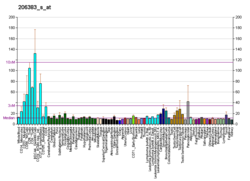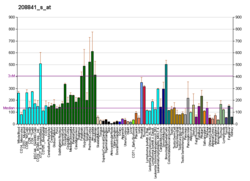Protein-coding gene in the species Homo sapiens
Ras GTPase-activating protein-binding protein 2 is an enzyme that in humans is encoded by the G3BP2 gene .[5] [6] [7]
Interactions [ edit ] G3BP2 has been shown to interact with IκBα .[8]
References [ edit ]
^ a b c GRCh38: Ensembl release 89: ENSG00000138757 – Ensembl , May 2017^ a b c GRCm38: Ensembl release 89: ENSMUSG00000029405 – Ensembl , May 2017^ "Human PubMed Reference:" . National Center for Biotechnology Information, U.S. National Library of Medicine .^ "Mouse PubMed Reference:" . National Center for Biotechnology Information, U.S. National Library of Medicine .^ Ishikawa K, Nagase T, Suyama M, Miyajima N, Tanaka A, Kotani H, et al. (June 1998). "Prediction of the coding sequences of unidentified human genes. X. The complete sequences of 100 new cDNA clones from brain which can code for large proteins in vitro" . DNA Research . 5 (3): 169–76. doi :10.1093/dnares/5.3.169 PMID 9734811 . ^ Kennedy D, Wood SA, Ramsdale T, Tam PP, Steiner KA, Mattick JS (June 1998). "Identification of a mouse orthologue of the human ras-GAP-SH3-domain binding protein and structural confirmation that these proteins contain an RNA recognition motif". Biomedical Peptides, Proteins & Nucleic Acids . 2 (3): 93–9. PMID 9575347 . ^ "Entrez Gene: G3BP2 GTPase activating protein (SH3 domain) binding protein 2" .^ Prigent M, Barlat I, Langen H, Dargemont C (November 2000). "IkappaBalpha and IkappaBalpha /NF-kappa B complexes are retained in the cytoplasm through interaction with a novel partner, RasGAP SH3-binding protein 2" . The Journal of Biological Chemistry . 275 (46): 36441–9. doi :10.1074/jbc.M004751200 PMID 10969074 .
Further reading [ edit ]
Kim MM, Wiederschain D, Kennedy D, Hansen E, Yuan ZM (June 2007). "Modulation of p53 and MDM2 activity by novel interaction with Ras-GAP binding proteins (G3BP)". Oncogene . 26 (29): 4209–15. doi :10.1038/sj.onc.1210212 . PMID 17297477 . S2CID 20028334 . Olsen JV, Blagoev B, Gnad F, Macek B, Kumar C, Mortensen P, Mann M (November 2006). "Global, in vivo, and site-specific phosphorylation dynamics in signaling networks" . Cell . 127 (3): 635–48. doi :10.1016/j.cell.2006.09.026 PMID 17081983 . S2CID 7827573 . Ong SE, Mittler G, Mann M (November 2004). "Identifying and quantifying in vivo methylation sites by heavy methyl SILAC". Nature Methods . 1 (2): 119–26. doi :10.1038/nmeth715 . PMID 15782174 . S2CID 6654604 . Ballif BA, Villén J, Beausoleil SA, Schwartz D, Gygi SP (November 2004). "Phosphoproteomic analysis of the developing mouse brain" . Molecular & Cellular Proteomics . 3 (11): 1093–101. doi :10.1074/mcp.M400085-MCP200 PMID 15345747 . Prigent M, Barlat I, Langen H, Dargemont C (November 2000). "IkappaBalpha and IkappaBalpha /NF-kappa B complexes are retained in the cytoplasm through interaction with a novel partner, RasGAP SH3-binding protein 2" . The Journal of Biological Chemistry . 275 (46): 36441–9. doi :10.1074/jbc.M004751200 PMID 10969074 . Yu W, Andersson B, Worley KC, Muzny DM, Ding Y, Liu W, et al. (April 1997). "Large-scale concatenation cDNA sequencing" . Genome Research . 7 (4): 353–8. doi :10.1101/gr.7.4.353 . PMC 139146 PMID 9110174 . Andersson B, Wentland MA, Ricafrente JY, Liu W, Gibbs RA (April 1996). "A "double adaptor" method for improved shotgun library construction". Analytical Biochemistry . 236 (1): 107–13. doi :10.1006/abio.1996.0138 . PMID 8619474 .






